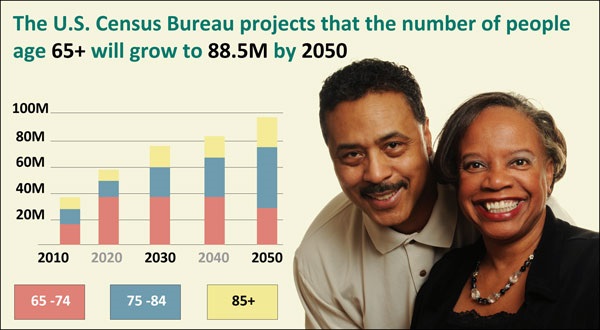Own a Recession-Resistant Business in a Booming Market
The prospect for future growth in the number of potential home care clients is truly amazing!
The largest and fastest growing segment of the population is comprised of seniors over the age of 65. These will constitute the majority of your Options For Senior America clients. People are living longer and life expectancy continues to grow annually, making care for older adults a true growth business.
As an Options For Senior America franchise owner, you will not only be joining one of the fastest growing industries at present but will also be contributing to your community in a positive manner to enhance the lifestyle of others. Providing care for others is a feel-good profession. Our franchise owners as well as our staff are proud of what they do.
You Have Options!

Are you going through the motions at work, paralyzed by the hum-drum of a corporate routine that leaves you feeling unfulfilled? Are you living in dread of the next wave of downsizing that will yank away your job and leave you vulnerable? Are you searching for meaningful work that impacts others’ lives? Consider our franchise in your area today! It’s the perfect opportunity to take control and ownership of your life and work and to find meaning and fulfillment in a growing industry that financially pays off!
Call us today at 1-800-267-8466 to discuss your Options!
A Profile of Older Americans
Source: Administration on Aging
- From 2007 to 2017 the population age 65 and over increased from 38 million to 49.2 million (a 33% increase) and is projected to double to 98 million in 2060.
- Over one in every seven, or 15.2%, of the U.S. population is an older American.
- Persons reaching age 65 have an average life expectancy of an additional 19.4 years (20.6 years for females and 18 years for males).
Projected Future Growth of the Older Population

- Between 2010 and 2050, the U.S. population is projected to grow from 310 million to 439 million, an increase of 42 percent.
- Between 2010 and 2050, the United States is projected to experience rapid growth in its older population. In 2050, the number of Americans aged 65 and older is projected to be 88.5 million,more than double its projected population of 40.2 million in 2010.
- About 3 million persons celebrated their 65th birthday in 2016. Presently, more than 10,000 people turn 65 every day in the United States
- There were 81,896 persons aged 100 or more in 2016 (0.2% of the total 65+ population). This is a 120% increase from the 1990 figure of 37,306.
(Source: Family Caregiver Alliance – National Center on Caregiving)
Who Needs Long-Term Care?
- Of the older population with long-term care needs in the community, about 30% (1.5 million persons) have substantial long-term care needs (three or more ADL limitations). Of these, about 25% are 85 and older and 70% report they are in fair to poor health.
(Source: Family Caregiver Alliance – National Center on Caregiving)
- Individuals 85 years and older, the oldest old, are one of the fastest growing segments of the population. In 2012, there are an estimated 5.9 million people 85+ in the United States. This figure is expected to increase to 19.4 million by 2050.
(Source: Family Caregiver Alliance – National Center on Caregiving)
Where do People Receive Long-Term Care and from Whom?

- 43.5 million caregivers provide care for someone aged 50+ and 14.9 million care for someone who has Alzheimer's or other Dementia.
(Source: National Alliance for Caregiving and AARP)
- The vast majority (80%) of elderly people receiving assistance, including many with several functional limitations, live in private homes in the community, not in institutions.
(Source: Family Caregiver Alliance – National Center on Caregiving)
- While caregivers can be found across the age span, the majority of caregivers are middle-aged (35-64 years old).
(Source: National Alliance for Caregiving and AARP)
- The number of Home Health Aides in 2018 was 3,253,000 and is expected to grow by 36% to reach 2,575,600 by 2028
(Source: Bureau of Labor Statistics)
More Stats
- About 70 percent of adult caregivers get help from family members, friends or neighbors. And about 30 percent rely on help from paid caregivers.
- Someone caring for a spouse spends more than 30 hours a week directly caring for their loved one and is less likely to get help from relatives or friends.
- Long-distance caregivers spend an average of $392 a month on travel and out-of-pocket expenses as part of their caregiving duties.



